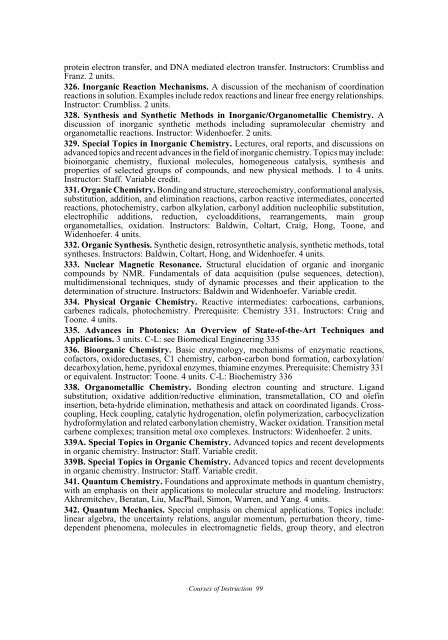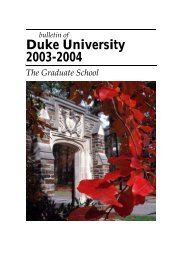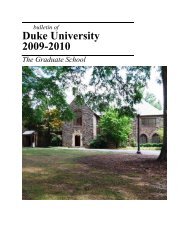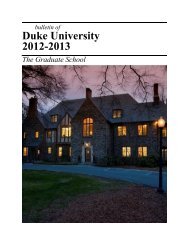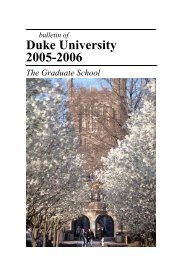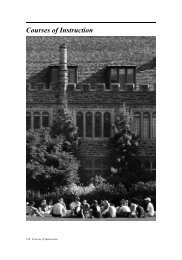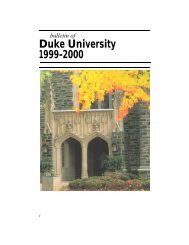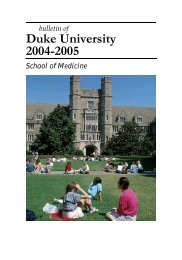Duke University 2008-2009 - Office of the Registrar - Duke University
Duke University 2008-2009 - Office of the Registrar - Duke University
Duke University 2008-2009 - Office of the Registrar - Duke University
You also want an ePaper? Increase the reach of your titles
YUMPU automatically turns print PDFs into web optimized ePapers that Google loves.
protein electron transfer, and DNA mediated electron transfer. Instructors: Crumbliss and<br />
Franz. 2 units.<br />
326. Inorganic Reaction Mechanisms. A discussion <strong>of</strong> <strong>the</strong> mechanism <strong>of</strong> coordination<br />
reactions in solution. Examples include redox reactions and linear free energy relationships.<br />
Instructor: Crumbliss. 2 units.<br />
328. Syn<strong>the</strong>sis and Syn<strong>the</strong>tic Methods in Inorganic/Organometallic Chemistry. A<br />
discussion <strong>of</strong> inorganic syn<strong>the</strong>tic methods including supramolecular chemistry and<br />
organometallic reactions. Instructor: Widenhoefer. 2 units.<br />
329. Special Topics in Inorganic Chemistry. Lectures, oral reports, and discussions on<br />
advanced topics and recent advances in <strong>the</strong> field <strong>of</strong> inorganic chemistry. Topics may include:<br />
bioinorganic chemistry, fluxional molecules, homogeneous catalysis, syn<strong>the</strong>sis and<br />
properties <strong>of</strong> selected groups <strong>of</strong> compounds, and new physical methods. 1 to 4 units.<br />
Instructor: Staff. Variable credit.<br />
331. Organic Chemistry. Bonding and structure, stereochemistry, conformational analysis,<br />
substitution, addition, and elimination reactions, carbon reactive intermediates, concerted<br />
reactions, photochemistry, carbon alkylation, carbonyl addition nucleophilic substitution,<br />
electrophilic additions, reduction, cycloadditions, rearrangements, main group<br />
organometallics, oxidation. Instructors: Baldwin, Coltart, Craig, Hong, Toone, and<br />
Widenhoefer. 4 units.<br />
332. Organic Syn<strong>the</strong>sis. Syn<strong>the</strong>tic design, retrosyn<strong>the</strong>tic analysis, syn<strong>the</strong>tic methods, total<br />
syn<strong>the</strong>ses. Instructors: Baldwin, Coltart, Hong, and Widenhoefer. 4 units.<br />
333. Nuclear Magnetic Resonance. Structural elucidation <strong>of</strong> organic and inorganic<br />
compounds by NMR. Fundamentals <strong>of</strong> data acquisition (pulse sequences, detection),<br />
multidimensional techniques, study <strong>of</strong> dynamic processes and <strong>the</strong>ir application to <strong>the</strong><br />
determination <strong>of</strong> structure. Instructors: Baldwin and Widenhoefer. Variable credit.<br />
334. Physical Organic Chemistry. Reactive intermediates: carbocations, carbanions,<br />
carbenes radicals, photochemistry. Prerequisite: Chemistry 331. Instructors: Craig and<br />
Toone. 4 units.<br />
335. Advances in Photonics: An Overview <strong>of</strong> State-<strong>of</strong>-<strong>the</strong>-Art Techniques and<br />
Applications. 3 units. C-L: see Biomedical Engineering 335<br />
336. Bioorganic Chemistry. Basic enzymology, mechanisms <strong>of</strong> enzymatic reactions,<br />
c<strong>of</strong>actors, oxidoreductases, C1 chemistry, carbon-carbon bond formation, carboxylation/<br />
decarboxylation, heme, pyridoxal enzymes, thiamine enzymes. Prerequisite: Chemistry 331<br />
or equivalent. Instructor: Toone. 4 units. C-L: Biochemistry 336<br />
338. Organometallic Chemistry. Bonding electron counting and structure. Ligand<br />
substitution, oxidative addition/reductive elimination, transmetallation, CO and olefin<br />
insertion, beta-hydride elimination, metha<strong>the</strong>sis and attack on coordinated ligands. Crosscoupling,<br />
Heck coupling, catalytic hydrogenation, olefin polymerization, carbocyclization<br />
hydr<strong>of</strong>ormylation and related carbonylation chemistry, Wacker oxidation. Transition metal<br />
carbene complexes; transition metal oxo complexes. Instructors: Widenhoefer. 2 units.<br />
339A. Special Topics in Organic Chemistry. Advanced topics and recent developments<br />
in organic chemistry. Instructor: Staff. Variable credit.<br />
339B. Special Topics in Organic Chemistry. Advanced topics and recent developments<br />
in organic chemistry. Instructor: Staff. Variable credit.<br />
341. Quantum Chemistry. Foundations and approximate methods in quantum chemistry,<br />
with an emphasis on <strong>the</strong>ir applications to molecular structure and modeling. Instructors:<br />
Akhremitchev, Beratan, Liu, MacPhail, Simon, Warren, and Yang. 4 units.<br />
342. Quantum Mechanics. Special emphasis on chemical applications. Topics include:<br />
linear algebra, <strong>the</strong> uncertainty relations, angular momentum, perturbation <strong>the</strong>ory, timedependent<br />
phenomena, molecules in electromagnetic fields, group <strong>the</strong>ory, and electron<br />
Courses <strong>of</strong> Instruction 99


